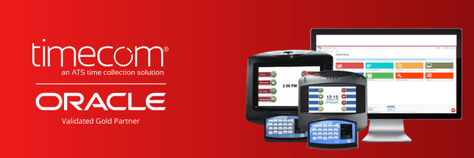In the spirit of responsible business practices, every company should have a well-documented employee attendance policy readily accessible to all its employees. This not only sets clear expectations but also underscores the collective responsibility of curbing excessive absenteeism.
Developing Your Reference Guide
Creating this reference guide requires careful consideration and effort to cover all pertinent aspects. To assist you, we're offering insights into key sections to include in your employee handbook's attendance policy.
To assist you in creating this reference guide, leverage the power of your Oracle HCM integration with our Timecom solution. This ensures precise attendance tracking, seamless data delivery to payroll system, it also offers insights into employee performance and policy compliance, enhancing efficiency according to your specific needs, with Timecom you will fully optimize your ROI of your Oracle integration cloud service.

Cover Page and Formatting
A document with an attractive cover page is more appealing to employees. Design the entire layout and formatting throughout your employee handbook to make it inviting and readable for your employees. Employees will remember the policy information better if it is simple to read and view.
Table of Contents
People will skim the table of contents before diving into the guide. A detailed table of contents gives employees a complete picture of all the topics that are covered in the employee attendance policy.
In your digital employee attendance policy, each table of contents entry should link directly to that page in the guide.
Mission and Purpose of the Policy
State the objectives of the employee attendance policy in the introduction. When employees understand the goals and reasons behind the policy, it helps improve compliance.
For example, one of the goals may be to collect attendance hours accurately to gain insight towards performance expectations. Thus, the policy requires employees to clock in and out so that attendance data is delivered via the Oracle integration or your preferred HCM software to all the necessary systems to run an accurate payroll.
When employees understand how their attendance data is used, they realize the importance of following rules when using time clocks.
Separate Chapters for Each Important Component of the Policy
Your guide should include a section dedicated to each of your employee attendance policy’s significant components. These can include:
Optional Sections
Here are some suggestions for other sections that may be helpful for your employee policy handbook.
Glossary
If you use technical jargon or acronyms in your guide, list the terms with their definitions so everyone has clarity on what they mean, this visual builder can assist viewers who need a visual aid.
Frequently Asked Questions
Provide a FAQ page that employees can use as a quick reference in real time scenarios.
Tools and Technology
Use this section to describe any tools or integration services used to manage attendance and absences. For example, a section could describe the application integration environment and the connection between your applications, data mapping is essential to inform your employees about so employees know where their attendance data is going.
It should also provide (or link to) user guides if employees use a time clock or Oracle integrated system to submit time off requests or view their upcoming schedule.
Getting Serious about Employee Attendance
You now have a good skeleton around which you can build your new employee attendance policy handbook. The result will be a document that’s helpful and makes policy compliance easy.
To learn more about time and attendance and begin creating an Employee Attendance Policy that sticks, download our free eBook The Step-By-Step Guide to Minimizing Absenteeism. Or get in contact with a team member by clicking the button below.

While ATS is passionate about time and attendance and excited to support organizations navigate workforce dynamics around timekeeping and employee time clocks, we recommend you reach out to your regional and/or local HR chapter for more information on common workplace advice and procedures.




